

IB Biology on effect on temperature on the activity of catalase enzym… Isbibbio - biological washing powders and enzymes. I'm sure all of us have gotten stains on our clothes at one point or another,such as blood, gravy or egg yolk.
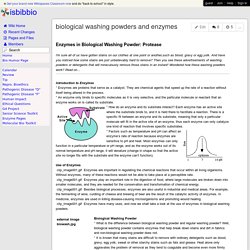
And have you noticed how some stains are just unbelievably hard to remove? Then you see these advertisements of washing powders or detergents that will miraculously remove those stains in an instant! Wondered how these washing powders work? Read on... Introduction to Enzymes ° Enzymes are proteins that serve as a catalyst. How do an enzyme and its substrate interact? ° Factors such as temperature and pH can affect an enzyme’s rate of reaction because enzymes are sensitive to pH and heat. Enzymes are important in regulating the chemical reactions that occur within all living organisms. Enzymes play an important role in the digestion of food, where large molecules are broken down into smaller molecules, and they are needed for the conservation and transformation of chemical energy. Besides biological processes, enzymes are also useful in industrial and medical areas. What's the Difference Between Bio & Non-Bio - Persil. Bio or non-bio detergent?
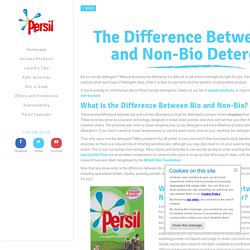
Without knowing the difference, it’s difficult to tell which one might be right for you. Persil is here to help! This handy guide explains what each type of detergent does, when it is best to use them, and the benefits of using either product. If you’re looking for information about Persil non-bio detergents, check out our list of laundry products, or read more about Persil small & mighty non-bio here. Biological detergent. A biological detergent is a laundry detergent that contains enzymes harvested from micro-organisms such as bacteria adapted to live in hot springs.[1] The description is commonly used in the United Kingdom, where other washing detergents are described as "non-biological" (or bio and "non-bio").

Most manufacturers of biological detergents also produce non-biological ones. Function[edit] Biological detergents clean in the same way as non-biological ones with additional effects from the enzymes, whose purpose is to break down protein, starches and fat in dirt and stains on clothing to be laundered, for example food stains, sweat and mud. Tests by the Consumers' Association in the UK published in their Which? Magazine rated the cleaning performance of washing powders based on stain removal, whiteness, and colour fading. GCSE Bitesize Science - Enzymes in action : Revision, Page 2. HL Worksheets. Chapter 1 - Statistical analysis Worksheet 1.1 Fifteen summary facts [Word]| [PDF]| Worksheet 1.2 Command term to master: 'Explain' [Word]| [PDF]| Chapter 2 - Cells Worksheet 2.1 Fifteen summary facts [Word]| [PDF]| Worksheet 2.2 Command term to master: 'State' [Word]| [PDF]| Chapter 3 - The chemistry of life.
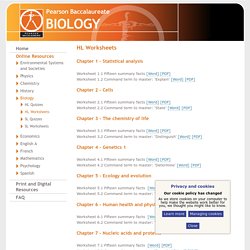
The Perfect Biology Lab Report. Lab Report = Surface area to volume ratio effect on diffusion. Irena Sionek 2IB Apparatus and materials (one of each for a group) Knife Ruler Beaker Measuring cylinder Timer Spoon Petri dish Weight Paper towels (optional) 96 cm3 water 4 g NaOH Tray of agar with phenolphthalein Method We have 6 groups making the very same experiment, so we have 6 trials.
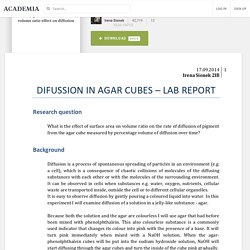
Cell’s Surface Area and Volume Lab. Biology Relationship Between A Cell’s Surface Area and Volume Ratio and it’s Diffusion Rate Introduction A cell’s effectiveness is partly based on its ability to transfer substances in and out of itself.
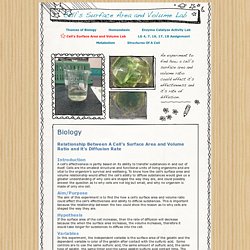
Cells are the smallest structural and functional units of living organisms and are vital to the organism’s survival and wellbeing. To know how the cell’s surface area and volume relationship would affect the cell’s ability to diffuse substances would give us a greater understanding of why cells are shaped the way they are, and could possibly answer the question as to why cells are not big but small, and why no organism is made of only one cell. Aim/Purpose The aim of this experiment is to find the how a cell’s surface area and volume ratio could affect the cell’s effectiveness and ability to diffuse substances. Hypothesis Variables Procedure •Safety Precautions oWhen dealing with acids, the experimenter must wear gloves, goggles and an apron •Apparatus needed to make the gelatin.
2.1.6 Explain the importance of the surface area to volume ratio as a factor limiting cell size. IB Biology HL Topic 2: Cells flashcards. [Lab Report] How to write a good biology lab report. - Biology and ESS. Okay, so I found a bunch of notes I took when my teachers were giving us IA tips and format..etc.
![[Lab Report] How to write a good biology lab report. - Biology and ESS](http://cdn.pearltrees.com/s/pic/th/lab-report-write-good-biology-118541888)
Some of the below I had to copy of the board, so you may find these in the books. So, Biology IAs should follow this general format:DESIGN1)Research Question2)Hypothesis/Predictions3)Variables4)Apparatus5)Method/procedure DCP1)Collected data2)Data processing3)Data presentation CE1)Conclusion2)Evaluation Design Research question:This should be a clear focused question that says exactly what you are investigating. Hypothesis:This is a paragraph or two where you explain your research question.
Variables:A list or a table that include:-Independent variable: this is the variable you're changing. Apparatus:This is the list where you include everything you are going to use. Method:I always prefer the method being in a list format rather than a paragraph.